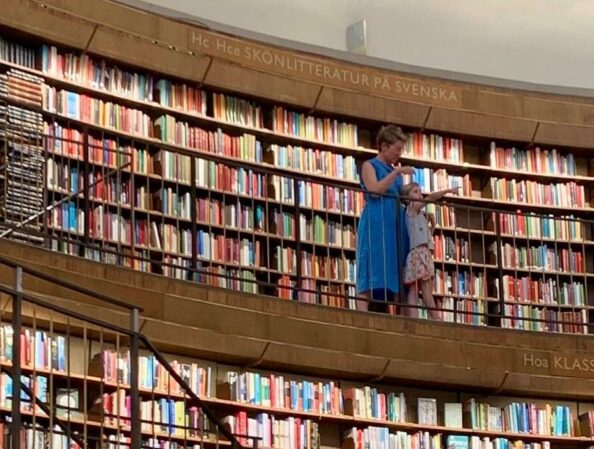On February 21st, the world celebrates International Mother Language Day. While Dutch is the dominant and official language in public and professional settings in the Netherlands, some studies show that 20% of the residents in the Netherlands don’t speak Dutch at home and many residents have multiple mother languages.
In this blog we’ll give you a little peek into the homes of two Taalhuis colleagues and their parenting experiences with multilingualism.
In Esin’s family there is Turkish, English and Dutch
Esin is the mother of an 8-year-old girl. Growing up in a diverse background herself, she knows what she wants for her daughter. Esin, who learns Dutch at Taalhuis Amsterdam and also works in the marketing and PR department, grew up in Istanbul, Turkey with a mother who understood the importance of diversity and language learning and a father who worked for a German company. They both supported Esin and her older brother in their language development through books, movies, and most importantly, traveling. They also often hosted visitors from abroad. This upbringing exposed Esin to different languages and multicultural environments. ‘’We spoke Turkish at home but we often listened to international music’’, she recalls.
Now that she is a mother herself, Esin intends to continue her family’s tradition. Since she has an American partner, her daughter has already been exposed to two languages in equal measure. Esin has always spoken exclusively in Turkish to her daughter, , while her partner spoke to her in English. Esin explains: “While I always spoke Turkish she used to reply in English most of the time. But around the time she turned 3 years old, she started replying to me in Turkish”
The family moved from the USA to the Netherlands when their daughter was two and a half years old. The little girl started her journey with Dutch as a third language in daycare. Esin remembers that she struggled with communication in the new Dutch speaking environment in the first months. With some support of a part time nanny who spoke excellent English and was a native Dutch speaker through songs, play, and books, they quickly bridged the gap and transitioned comfortably to speaking Dutch before she started school at 4 years old. Esin happily remembers one of her daughter’s first songs in Dutch, ‘op een grote paddestoel’.
Now Esin’s daughter is a multilingual child in ‘groep 5’ who speaks Turkish, English, and Dutch equally and fluently.

Egyptian Arabic bedtime stories every day
Taalhuis’ Egyptian Arabic teacher, Nehal tells her story as a mother to a 10-year-old boy. Although both parents speak the same language and are both Egyptians, moving to the Netherlands wasn’t easy when the boy was three and a half years old. He couldn’t communicate with anyone after leaving his big, loving family in Egypt. He felt like his whole world had suddenly changed, and he needed to adapt. He began learning Dutch at school while his parents spoke to him in Egyptian Arabic at home. He used to listen to his parents speaking English with others. As a result he spent a couple of years surrounded by Arabic, Dutch, and English. Since Nehal also had to learn a new language (Dutch), she felt that their learning process became mutual. They were learning mates, made friends, and learned languages together.
Now he is 10 years old, and Dutch has become his dominant language, even though the family still speaks Egyptian Arabic at home. Nehal reads to her boy in Egyptian and MSA Arabic every night. She believes that raising multilingual children teaches us much about ourselves, our children, and the wonders that the human brain is capable of.
Multilingualism as an advantage
Our brains control how we switch from one language to another. Each language we learn has its own system in our brains. Studies suggest that children who speak more than one language from a young age have a different way of switching between languages than those who learn a second language at a later stage.
“Switching between languages became structural in my daughter’s brain”, Esin says, and she believes that being multilingual contributes to children’s openness to others. This variety of languages from a young age helps children build compassion -without realising it- by connecting to other languages and cultures.
Esin expresses how multilingualism is an advantage: “When we go to any country, my daughter is interested in the new language and culture she is exposed to. She is excited, open, and easily builds experiences and relationships with people. I want to give her the love of life through languages. I want her to see that she can be anywhere in the world and make a connection with people”.
Elasticity of the brain
A study suggests that multilingual children tend to filter educational content more effectively than monolingual children from a young age. They extract the main goal of any content while ignoring what they think is unknown or unnecessary. This skill makes them more flexible and adaptable later on according to targeted educational goals and generally in life as their brains have mastered these skills in learning more than one language daily during early childhood.
Nehal remembers that when her son was 5 years old she used to ask him about the meaning of new Dutch vocabulary while reading stories. Although he didn’t know the meaning precisely, he absorbed the whole context of the story. He subconsciously used a process of filtering and concluding the text and context.
Children have unimaginable ways of building connections between languages, whether they have one mother tongue or a couple.


